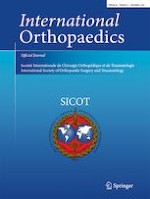Published in:

01-12-2019 | Knee-TEP | Original Paper
Social determinants associated to chronic pain after total knee arthroplasty
Authors:
Rodrigo Núñez-Cortés, Claudio Chamorro, Maritza Ortega-Palavecinos, Gustavo Mattar, Orlando Paredes, Álvaro Besoaín-Saldaña, Carlos Cruz-Montecinos
Published in:
International Orthopaedics
|
Issue 12/2019
Login to get access
Abstract
Aim of the study
Analyze the association between social health determinants (SHD) and chronic post-surgical pain (CPSP) after total knee arthroplasty (TKA).
Method
A cross-sectional study was performed in 58 TKA patients. The subjects were classified in two groups: with (n = 22) or without (n = 36) CPSP. SHD considered were gender, age, educational level, economic income, and labour conditions.
Results
Significant differences were found concerning educational level when comparing subjects with or without CPSP, with a low educational level of 22.4% and 19%, respectively. 15.5% of patients with persistent pain had a high educational level compared with 43.1% of the patients without persistent pain (p = 0.032). No significant differences were found for the other categories (p > 0.05). The odds ratio (95% confidence interval) was 3.28 (1.09–9.93) for lower educational level compared with high educational level.
Discussion
CPSP must be considered a severe health problem. In addition to SDH, there are multiple factors associated with chronic pain after TKA that must be considered for an effective treatment.
Conclusions
Patients with lower educational level showed a three-time higher association to develop CPSP. Considering SHD could be of relevance when elaborating new interventions or health strategies and more specialized counseling for patients with persistent pain after TKA.